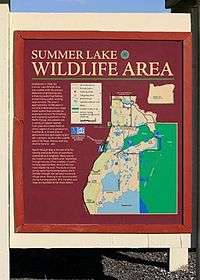Summer Lake, Oregon
| Summer Lake | |
|---|---|
|
One-room Harris school built in 1890 | |
 Summer Lake Location in Oregon | |
| Coordinates: 42°58′23″N 120°46′37″W / 42.973°N 120.777°WCoordinates: 42°58′23″N 120°46′37″W / 42.973°N 120.777°W | |
| Country | United States |
| State | Oregon |
| County | Lake |
| Elevation | 4,229 ft (1,289 m) |
| Population (2005) | |
| • Total | 90 |
| Time zone | Pacific (UTC-8) |
| • Summer (DST) | Pacific (UTC-7) |
| ZIP code | 97630 |

Summer Lake is an unincorporated community in northwest Lake County, Oregon, United States. It is on Oregon Route 31 approximately halfway between Bend and Lakeview. It is at the base of the eastern slope of Winter Ridge adjacent to the Fremont–Winema National Forests.
History
Summer Lake, for which the town is named, is one of the largest in Oregon at approximately 20 miles (32 km) long and 10 miles (16 km) wide.[1] It was named by Captain John C. Frémont during his 1843 mapping expedition through Central Oregon.
Frémont and his Army Topographical team were mapping the Oregon Country as they traveled from The Dalles on Columbia River to Sutter's Fort in Sacramento, California. On December 16, 1843, the expedition struggled down a steep cliff from a snow-covered plateau to reach a lake in the valley below. Frémont named them "Winter Ridge" and "Summer Lake."[2] From the rocky cliff overlooking the lake basin, Frémont described the discovery and naming of Summer Lake as follows:
"At our feet...more than a thousand feet below...we looked into a green prairie country, in which a beautiful lake, some twenty miles (32 km) in length, was spread along the foot of the mountain...Shivering on snow three feet deep, and stiffening in a cold north wind, we exclaimed at once that the names of Summer Lake and Winter Ridge should be applied to these proximate places of such sudden and violent contrast." (Captain John C. Frémont, December 16, 1843, Report of the Second Frémont Expedition)[3]
The first settlers began to arrive in the Summer Lake Valley around 1870. However, the high desert was difficult to farm, and many early settlers stayed only a few years before moving on to greener country.[4] As a result, the population of the valley never grew beyond a few hundred people.
Climate
This climatic region is typified by large seasonal temperature differences, with warm to hot (and often humid) summers and cold (sometimes severely cold) winters. According to the Köppen Climate Classification system, Summer Lake has a humid continental climate, abbreviated "Dfb" on climate maps.[5]
Economy
Facilities in Summer Lake include a post office, gas station, store, motel, restaurants, and several bed and breakfast establishments.[6]
Parks and recreation
There is a wayside park located across the highway from the post office and store that has six interpretive markers highlighting the Frémont Expedition's travel through the Summer Lake basin, the geology of the Summer Lake region, and Oregon's Outback Scenic Byway.
Museums and sites of interest
Summer Lake is home to the well-preserved nineteenth-century Harris School, a one-room schoolhouse built in 1890 by the Harris family, who were among the first pioneer families to settle in the Summer Lake area. The school closed in 1919, and then briefly reopened in 1926 for three more years. In 1929, Summer Lake students began attending school in Paisley twenty miles (32 km) south of Summer Lake.[1][7]
Wildlife refuge
The Summer Lake Basin supports more than 250 species of birds including bald eagles, Canada geese, white faced ibis, yellow-headed blackbirds, goshawks, hermit thrushes, red-tail hawks, great blue herons, and numerous species of ducks. This makes Summer Lake a favorite bird watching and hunting area.[8]
The Oregon Department of Fish and Wildlife maintains the Summer Lake Wildlife Area on the north side of the lake. The refuge consists of a large wetland marsh fed by the Ana River and associated high desert uplands with an 8.3-mile (13.4 km) tour route open to the public most of the year.[9]
The refuge headquarters and several housing units are located adjacent to Oregon Route 31 at the south end of the town.[9] The Department of Fish and Wildlife operation and the visitors who come to the refuge are an important part of the Summer Lake economy.
-
.jpg)
- Summer Lake
-

- Refuge sign
-
.jpg)
- Sandhill cranes
-
.jpg)
- Ducks and egret
References
- 1 2 Morris, Elizabeth and Mark, "Summer Lake", Moon Handbooks: Oregon, Avalon Travel Publishing, 2004.
- ↑ "Fremont Memorial", Oregon Historical Marker, Summer Lake, Oregon, 2008.
- ↑ Nevins, Allen, Fremont: Pathmaker of the West, University of Nebraska Press, Lincoln, Nebraska, 1992, p. 149.
- ↑ Allen, Cain, "Lula Schminck & Florence Klippel on Summer Lake Lava Beds", Oregon History Project, Oregon Historical Society, 2005
- ↑ Climate Summary for Summer Lake, Oregon
- ↑ Lasater, Erika, and Denny Paul, "Places to Visit in Oregon's Outback", Oregon's Outback.com, January 21, 2008.
- ↑ "Harris Schoolhouse", Oregon Historical Marker, Summer Lake, Oregon.
- ↑ "Summer Lake Wildlife Refuge", Southern Oregon Visitor Guide, Southern Oregon Visitors Association, Ashland, Oregon, 2006.
- 1 2 "Summer Lake Wildlife Area", Oregon Department of Fish and Wildlife, Salem, Oregon, October 19, 2005.
| |||||||||||||||||||||
.jpg)
